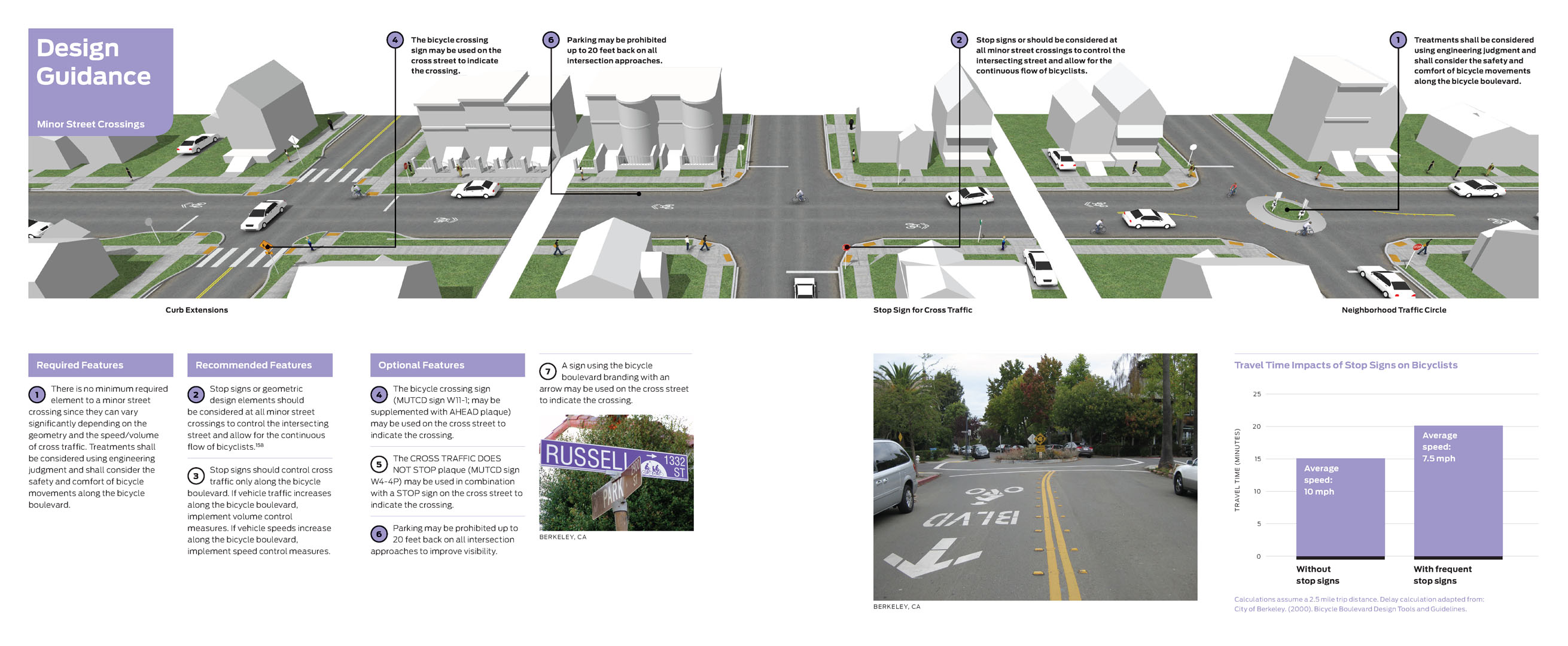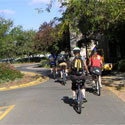Description
Minor Street Crossings for bicycle boulevards typically involve the intersection of two residential or local streets with low motor vehicle volumes and speeds. At intersections with local streets and minor collectors, bicycle boulevards should have right-of-way priority and reduce or minimize delay by limiting the number of stop signs along the route. Stretches of at least a half mile or more of continuous travel without stop sign control are desirable.
Stop signs along a bicycle boulevard increase travel time for bicyclists and may be viewed as unnecessary, resulting in low compliance and unpredictability. On many local streets, stop signs are ‘woven’ such that travelers along local streets must stop at every other intersection. On bicycle boulevards this pattern should be altered to remove stop signs on the bikeway and reorient them towards intersecting local streets. This provides clarity at the intersections, while creating a more continuous flow of bicycle travel. Speed and volume control measures should be used in coordination with this approach to prevent these conditions from becoming attractive to motorists as a shortcut.
A bicycle boulevard should have traffic control and/or geometric design elements at all intersections to reduce conflicts. Neighborhood traffic circles can help direct traffic where stop controls are not appropriate. Parking can be prohibited on the intersection approaches and a pavement marking placed in the intersection so that the approaching driver on the cross street knows to expect bicyclists crossing.
See route planning for guidance on crossing treatment selection.
Click on the images below to view 3D concepts of minor street crossing treatments.
Treatment details can be accessed below under design guidance.
Benefits
- Enabling bicyclists to ride along the corridor with few stops significantly reduces travel time, minimizes bicyclist effort, and can improve compliance. Read More+
“A typical bicycle trip of 30 minutes is increased by 33% to 40 minutes if there is a STOP sign at every block.”
City of Berkeley. (2000). Bicycle Boulevard Design Tools and Guidelines.
“A cyclist who rolls through a stop at 5 mph needs 25 percent less energy to get back to 10 mph than does a cyclist who comes to a complete stop.”
Fajans, J., and M. Curry. (2001). Why Bicyclists Hate Stop Signs. Access. 18:28-31.
Typical Applications
- Wherever the bicycle boulevard is stop controlled at an intersection with a minor street, consider turning the stop signs to stop the cross traffic, thereby maximizing through bicycle connectivity and preserving bicyclist momentum.
- At uncontrolled intersections of minor streets, neighborhood traffic circles may be used to reduce conflicts and maintain appropriate speeds. See speed management for a discussion of traffic circles and other related treatments.
Design Guidance

Click the image above to see the guidance summary page full screen.
| Required Features |
 |
There is no minimum required element to a minor street crossing since they can vary significantly depending on the geometry and the speed/volume of cross traffic. Treatments shall be considered using engineering judgment and shall consider the safety and comfort of bicycle movements along the bicycle boulevard. |
| Recommended Features |
 |
Stop signs or geometric design elements should be considered at all minor street crossings to control the intersecting street and allow for the continuous flow of bicyclists. Read More+
“The use of YIELD or STOP signs should be considered at the intersection of two minor streets or local roads where the intersection has more than three approaches and where one or more of the following conditions exist:
A. The combined vehicular, bicycle, and pedestrian volume entering the intersection from all approaches averages more than 2,000 units per day;
B. The ability to see conflicting traffic on an approach is not sufficient to allow a road user to stop or yield in compliance with the normal right-of-way rule if such stopping or yielding is necessary; and/or
C. Crash records indicate that five or more crashes that involve the failure to yield the right-of-way at the intersection under the normal right-of-way rule have been reported within a 3-year period, or that three or more such crashes have been reported within a 2-year period.”
Federal Highway Administration. (2009). Manual on Uniform Traffic Control Devices. 2B.04.
“A YIELD or STOP sign should not be installed on the higher volume roadway unless justified by an engineering study. … The following are considerations that might influence the decision regarding the appropriate roadway upon which to install a YIELD or STOP sign where two roadways with relatively equal volumes and/or characteristics intersect:
A. Controlling the direction that conflicts the most with established pedestrian crossing activity or school walking routes*;
B. Controlling the direction that has obscured vision, dips, or bumps that already require drivers to use lower operating speeds; and
C. Controlling the direction that has the best sight distance from a controlled position to observe conflicting traffic.”
Federal Highway Administration. (2009). Manual on Uniform Traffic Control Devices. 2B.04.
*Note: this should extend to bicycle crossings as well.
|
 |
Stop signs should control cross traffic only along the bicycle boulevard. If vehicle volumes increase along the bicycle boulevard, implement volume control measures. If vehicle speeds increase along the bicycle boulevard, implement speed control measures. |
| Optional Features |
 |
The bicycle crossing sign (MUTCD sign W11-1; may be supplemented with AHEAD plaque) may be used on the cross street to indicate the crossing. |
 |
The CROSS TRAFFIC DOES NOT STOP plaque (MUTCD sign W4-4P) may be used in combination with a STOP sign on the cross street to indicate the crossing. |
 |
Parking may be prohibited up to 20 feet back on all intersection approaches to improve visibility. |
 |
A sign using the bicycle boulevard branding with an arrow may be used on the cross street to indicate the crossing. |
Treatment Adoption and Professional Consensus
Several jurisdictions have turned stop signs and consider bicycle connectivity a key factor in the development of bicycle boulevards.